Google S10 Signaling Apparatus User Manual voltage
Nest Labs Inc Signaling Apparatus voltage
Google >
Contents
- 1. user manual battery
- 2. user manual voltage
user manual voltage

Nest Protect Wired 120V ~ 60Hz
Detects smoke and carbon monoxide (CO)
User’s Guide
Please read carefully and save this user’s guide in a safe place.
05C
DRAFT
Page: 1

3 2
Nest Protect Backplate 120V connector
Four mounting screws
Three wire nuts
Meet your Nest Protect
Inside the box you’ll find:
Nest Protect is designed to detect smoke and carbon monoxide in a residential
environment. Its eight sensors work together to understand what’s happening in your
home. Its photoelectric sensor detects slow, smoldering fires. Nest Protect can be used as
a single station or multiple station alarm.
This guide covers the installation of Nest Protect Wired - Model number O5C.
Requirements
Wi-Fi, iOS or Android smartphone or tablet, and a free Nest account are required for
wireless interconnect, room names, mobile notifications and software updates. After
all the Nest Protects in your home have been connected with one another, they can
communicate with each other without Wi-Fi.
Table of content
Meet your Nest Protect 3
Location in your home 5
Placement on the ceiling or wall 6
Placement on a sloped ceiling 7
Setup and installation 8
Operating instructions 12
Heads-Up and Emergency Alarms 14
Wireless interconnect 15
Testing Nest Protect 16
General maintenance 17
Safety 19
Alarms limitations 19
Installation code 21
Carbon monoxide precautions 24
Fire safety precautions 26
FCC compliance 27
Page: 3 Page: 2
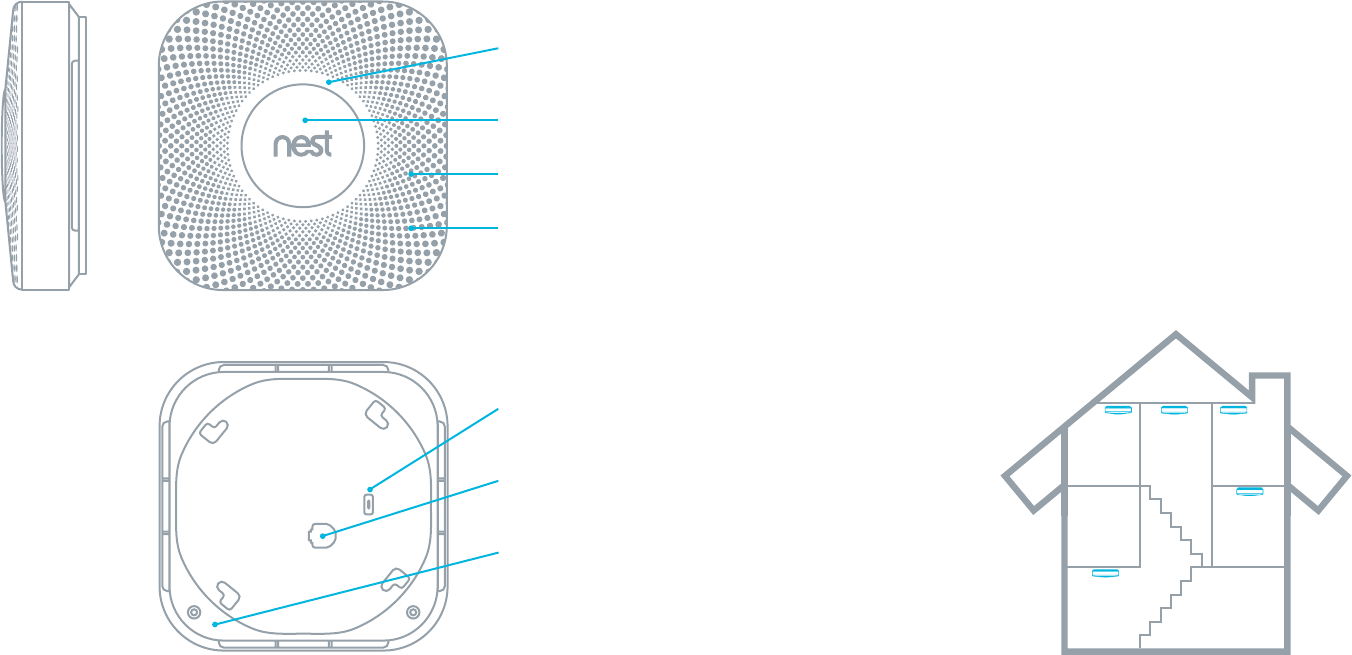
5 4
Light ring changes
color to alert you.
Nest button to hush alarms
and run a test.
Speaker allows Nest Protect
to speak with a human voice.
Horn enables Nest Protect
to alert you with a loud
emergency sound.
Micro-USB connector
(not for normal use).
AC connector pins for the
120V connector.
Backup battery
compartment:
3 AA Energizer® Ultimate
Lithium batteries (L91).
6”
(15.2cm)
1”
(2.5cm)
Location in your home.
The National Fire Protection Association recommends installing a smoke alarm in the
following areas:
• On every oor, including nished attics and basements.
• Inside and outside every sleeping area.
• At the top of the rst-to-second oor stairway and on the basement ceiling near
the entry of the stairs.
• In homes with more than 1,000 square feet on one level, additional alarms may
be required.
If you’d like, you can install Nest Protect closer to cooking appliances than conventional
smoke alarms, but we recommend it be at least 5 feet (1.5 meters) away, preferably 10 feet
(3 meters) from cooktops or cooking appliances.
Nest Protect should NOT be installed in unfinished attics or garages.
BEDROOM MASTER
BEDROOM
LIVING/
FAMILY
ROOM
KITCHEN
GARAGEBASEMENT
HALL
ATTIC
Page: 5 Page: 4

7 6
Placement on the ceiling or wall.
Installing on the ceiling is recommended. Mark where the screws will go using the base as
a guide. Make sure you’re at least 4 inches (10 cm) away from the wall.
Placement on a sloped ceiling.
If you have a sloped, peaked or cathedral ceiling, Nest Protect should be 4 inches to 3 feet
(10cm-1m) from the highest point.
Figure 1
Figure 2 Figure 3
Figure 4
Page: 7 Page: 6
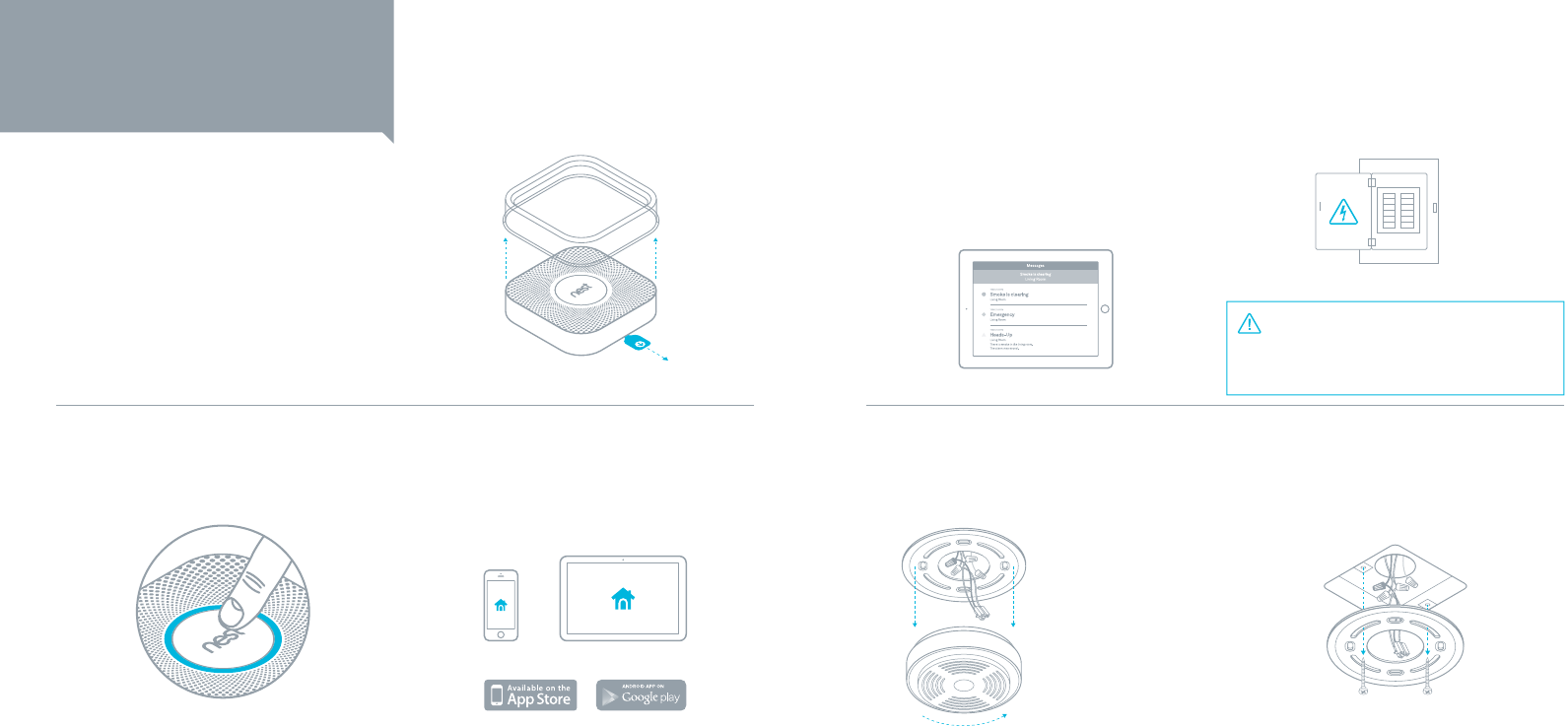
9 8
SETUP AND INSTALLATION
(Professional installation recommended)
Tip: Lay everything out on a table for an easy installation.
1. Wake it up
Remove the dust cover and pull out the
battery tab to wake up your Nest Protect.
2. Press the Nest button
Nest Protect will glow blue when it’s awake.
3. Get the Nest Mobile app
You’ll use the Nest Mobile app to get Nest
Protect connected to your Wi-Fi, to the
Internet, and to additional Nest Protects in
your home.
4. Set up Nest Protect
The video at nest.com/protect-setup
shows how.
The app will guide you through making
a free Nest account, pairing your Nest
Protect securely, and telling Nest Protect
which room it’s in.
5. Turn off power
Protect yourself and avoid blowing a fuse.
Switch off the correct circuit breaker or
remove the fuse from the fuse box.
Breaker box
6. Remove your old smoke alarm
Make sure the green LED on the old alarm
is off then pull your old smoke alarm off its
base, and disconnect its power wires.
Your old smoke
alarm might
make a really loud
noise when you
disconnect it.
7. Remove the old base
Unscrew the base plate from the electrical
box. Save the screws for later.
The installation of a smoke/CO alarm should be
made by a qualified technician, and all wiring
used to install this alarm should be made in
accordance with articles 210, and 300.3B of the
National Electrical Code ANSI/NFPA 70, NFPA 72,
and/or applicable codes in your local jurisdiction.
For a complete set of instructions and warnings,
refer page 22.
22
1
WARNING
ELECTRICAL SHOCK HAZARD
Failure to turn off the power may result in
serious electrical shock, injury and death.
Page: 9 Page: 8
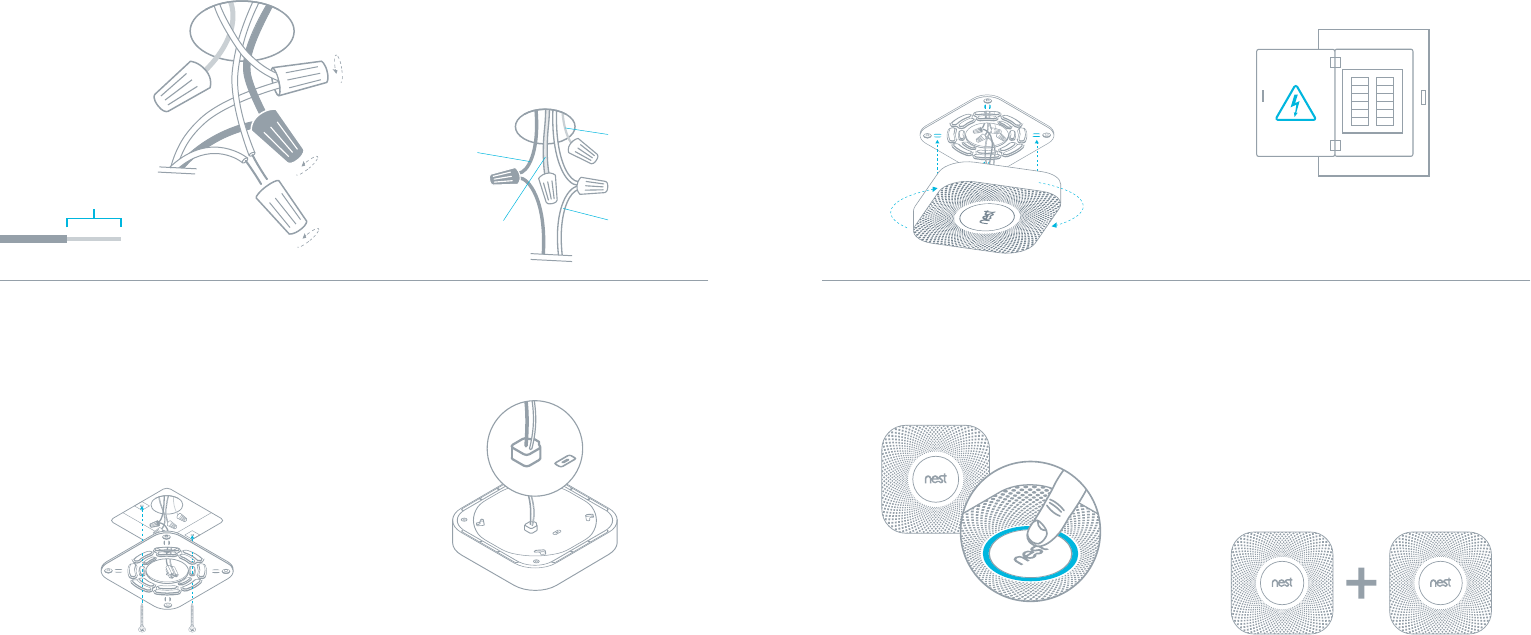
11 10
9. Attach the 120V connector
Just match the wires - white to white and
black to black. Press the wires together, cap
them with a wire nut and twist clockwise.
Tighten until it is secured. Nest Protect
interconnects wirelessly. There is no need
for the red/orange/yellow wire. Cap it with
a wire nut.
10. Install backplate
Screw the backplate to the wall or ceiling
using the included screws. You can use
two or four screws in any open slot on the
backplate. Make sure the backplate is
squared-up with the wall.
Refer to the diagrams on pages 6 and 7 for
proper placement of your Nest Protect.
11. Connect power
Plug the 120V connector into the back of
your Nest Protect.
12. Mount your Nest Protect
First, tuck any excess wiring into the
electrical box and line up Nest Protect
with the backplate.
Second, give it a slight twist clockwise.
It’ll CLICK into place.
13. Switch power back on or replace
the fuse
Breaker box
15. Have more smoke alarms?
Repeat steps 1-14 to install more Nest Protects.
The Nest app will help you connect them to
Wi-Fi and add them to your Nest Account.
Test that all your Nest Protects are
wirelessly connected by pushing the Nest
button twice on one Nest Protect. If they’re
connected, every Nest Protect in the house
will speak up. Walk to each one to make
sure you hear them talking.
14. Press to test
Press the Nest button. Your Nest
Protect will run a test and tell you when
it’s done.
Black:
Power line
Bare copper
Red/orange/yellow:
Interconnect
White:
Neutral line
8. Prepare the wires
Unscrew the wire
nuts to detach the
electrical connection
from your old smoke
alarm.
Make sure the
exposed wires
coming out of the
ceiling are clean
and straight.
3/8”
The exposed wire should be straight.
2 2
11
Page: 11 Page: 10
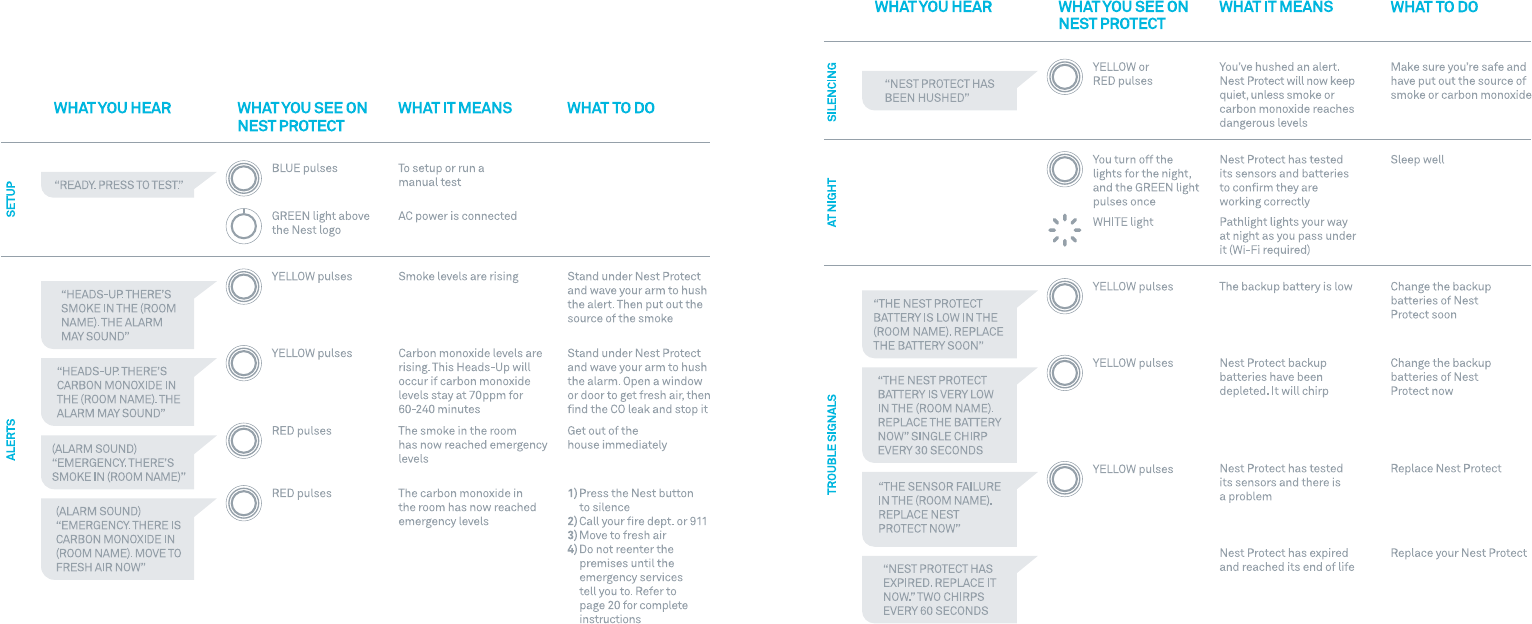
13 12
OPERATING INSTRUCTIONS
When Nest Protect smoke and carbon monoxide (CO) alarm has something to say, it will speak to you in
words and colors instead of just beeping. It has two kinds of voice alerts: Heads-Up and emergency alarms.
• Nest Protect can see smoke or carbon monoxide levels rising. So before it turns on an emergency
alarm, Nest Protect gives you a friendly spoken Heads-Up to warn you in advance. It pulses yellow
and speaks to you, telling you what and where the danger is.
• When smoke or carbon monoxide reach dangerous levels, Nest Protect tells you where the emergency
is and pulses red, in addition to making a loud alarm sound. This is an emergency alarm.
Page: 13 Page: 12
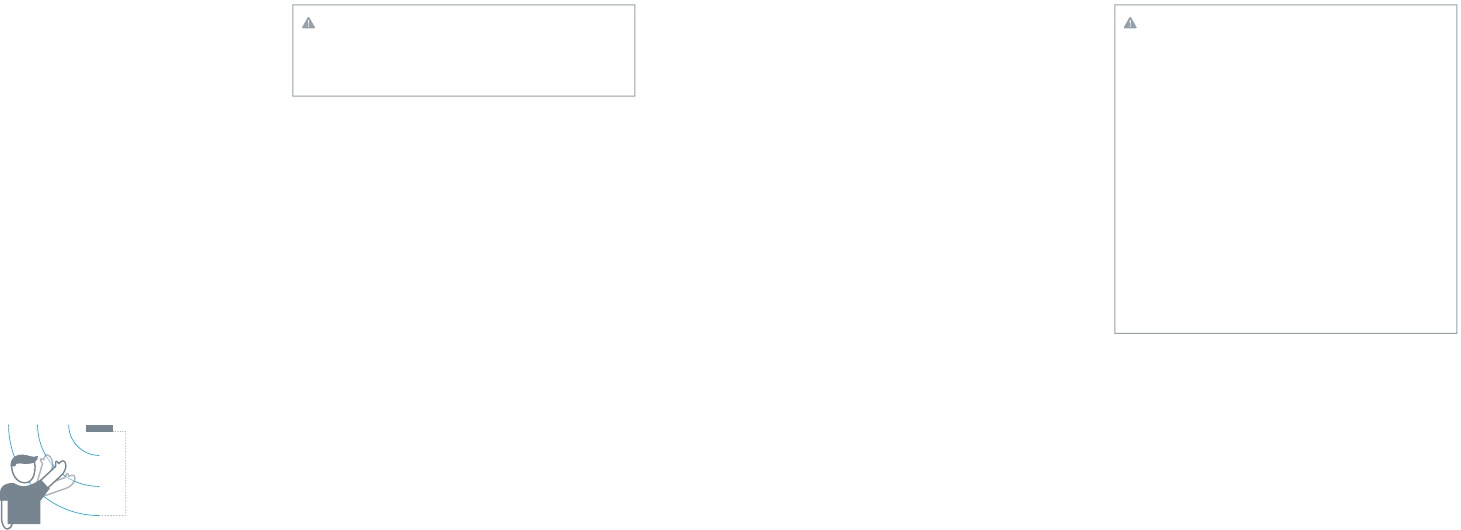
15 14
WARNING
Before waving at Nest Protect to silence it,
identify the source of the danger and make
sure you’re safe.
Your hand should be 2 ft – 6 ft (15 cm – 1.8 m) away
from Nest Protect when you wave. If your hand is
within this range, Nest Protect will tell you that it
is ready to be hushed. Children or pets are not tall
enough to accidentally trigger the Nest Wave.
You can also push the Nest button to quiet
Nest Protect.
WHICH ALERTS CAN BE HUSHED
• Heads-Up alerts can be hushed by using Nest
Wave or the Nest button.
• Emergency alarms cannot be hushed by using
Nest Wave or the Nest button if the smoke or
carbon monoxide levels reach emergency level.
Because there are many different types of
fires, you may experience an Emergency alarm
without having first experience a Heads-Up
alert. This means that dangerous levels of smoke
or CO occur extremely quickly and Nest Protect
had to sound the Emergency alarm.
• After the Nest Protects in your home are
connected to each other, whenever there’s a
Heads-Up in one room, they’ll all tell you what
and where the danger is. So go to that room and
wave at the Nest Protect there to hush every
Nest Protect in the home. This will ensure that
you will identify the source of the danger in
that room.
2 ft to 6 ft
15 cm to 1.8 m
WARNING
• Nest Protect is not compatible with smoke/
CO alarms from other manufacturers. Nest
Protect wireless interconnect will not work
with other products from other brands. We
recommend using only Nest Protect alarms.
• The range and proper operation of any
wireless device will vary depending on
its surroundings.
• Nest Protect alarms are not to be used
outdoors or to transmit between buildings.
The alarms will not communicate properly
in those conditions.
• Metal objects and metallic wallpaper may
interfere with signals from wireless alarms.
Test your Nest Protects with metal doors
opened and closed.
PATHLIGHT
Usually Nest Protect has its light turned off, but
it will light your way when it’s dark as you walk
underneath it. You can enable Pathlight from the
Nest Mobile app.
HEADS-UP AND EMERGENCY ALARMS
ALERTS
Nest Protect has two kinds of voice alerts: Heads-
Up and emergency alarms. Both tell you what and
where the danger is, but the spoken Heads-Up
is designed to give you a friendly warning before
conditions get dangerous.
A Heads-Up can be silenced by standing
underneath Nest Protect and waving at it or
pushing the Nest button.
When smoke or carbon monoxide reach dangerous
levels, Nest Protect tells you where the emergency
is and pulses red, in addition to making a loud
alarm sound. This is an emergency alarm.
The smoke alarm will take precedence when
carbon monoxide is also present.
NEST WAVE™
You can silence Nest Protect by simply standing
under it and waving at it.
Dense smoke or rising CO level will override Nest
Wave and sound a continuous alarm.
WIRELESS INTERCONNECT
Nest Protects connect wirelessly to each other so
that when one speaks, they all speak. That means
when one Nest Protect raises any kind of alerts,
every Nest Protect in the house will tell you in
which room the smoke or CO is in. For example,
if you’re in the bedroom and the alarm goes off in
the basement, the Nest Protect in the bedroom
will speak up and relay that alarm so that you
know where the danger is. To silence the alert, go
to that room and wave at the Nest Protect there.
That will hush every Nest Protect in the house.
Nest Protect’s 120V connector does not have a
red/orange/yellow wire for interconnect as it
connects wirelessly. There’s no need to connect
any wire to the red/orange/yellow interconnect wire
from the ceiling/wall.
Nest Protects can typically communicate with
each other if they’re 50 ft (15m) apart inside a
home. Some features of a home may reduce
their range, including the number of oors,
number/size of rooms, furniture, type of building
material, suspended ceilings, ductwork, large
metallic appliances and metal studs. This kind of
interference can be overcome by adding more
Nest Protects that can route wireless signals
around obstructions.
Nest Protect - Battery (model number 05A) and
Nest Protect - Wired 120V (model number 05C) are
compatible and can be interconnected wirelessly.
Page: 15 Page: 14

17 16
GENERAL MAINTENANCE
CLEANING YOUR NEST PROTECT
Use a damp cloth to clean your Nest Protect. Don’t
clean it with detergents or solvents (like Windex®)
and do not spray air fresheners, hair spray or other
aerosols near it. These chemicals will damage your
smoke alarm and make it non-operational. Do not
disassemble your Nest Protect or clean inside. If a
continuous alarm occurs, return for servicing. Do
not get water inside the alarm. Do not paint over
Nest Protect, as paint will seal the vents and affect
its ability to detect smoke and CO.
RESETTING YOUR NEST PROTECT
If you’re selling your home and leaving your Nest
Protect behind, you can reset it to erase all your
settings. Resetting will reset the wireless
interconnection between Nest Protects.
1. Turn off power.
2. Remove Nest Protect from the wall or ceiling
by twisting it counter-clockwise. Unplug the
120V connector from Nest Protect.
3. Climb down from your step-stool or ladder.
You’ll need both hands to perform the reset.
4. Using a pen or paper clip, push and hold the
ERASE ALL SETTINGS button on the back of
Nest Protect.
5. While you’re holding the ERASE ALL SETTINGS
button, push and hold the Nest button on the
front of Nest Protect.
6. Now you can release the ERASE ALL SETTINGS
button and the Nest button.
7. Nest Protect will tell you it’s erasing all
settings. After a few seconds it will restart.
8. Place Nest Protect back on the wall/ceiling.
9. Turn on power.
After resetting Nest Protect, it will still detect
smoke and carbon monoxide.
Test procedure
• Press the Nest button.
• Nest Protect will say: “Ready. Press to test”.
• Press the Nest button again.
• Nest Protect will say: “This is only a test. The
alarm may sound. The alarm is loud.
The test starts in ten seconds.
Ten. Nine. Eight. Seven. Six. Five. Four. Three. Two.
One. I’m starting the test.”
• You will see: Nest Protect will ash its lights in
several colors.
• Once the Nest Protect test is nished in the
room, Nest Protect will tell you everything’s okay.
If they are interconnected, every Nest Protect will
speak up in the house. Walk to each one to make
sure you hear them.
WARNING
• If the alarm ever fails to test correctly,
have it replaced immediately! If the alarm
is not working properly, it cannot alert you
to a problem.
• DO NOT use a match, cigarette or any other
makeshift fire to test the smoke alarm.
• To test the CO alarm, NEVER use vehicle
exhaust! Exhaust may cause permanent
damage and voids your warranty.
• NEVER use an open ame of any kind to
test this alarm. You might accidentally
damage or set fire to the unit or to your
home. The built-in self test accurately
tests the unit’s operation as required by
Underwriters Laboratories, Inc. (UL).
TESTING NEST PROTECT
SELF-MONITORING
Nest Protect continuously tests itself to ensure
that everything is working fine, so you don’t have
to wonder if it is working or not. Nest Protect will
check its battery and sensors and will let you
know if it has a message for you.
When you turn out the lights for the night, Nest
Protect will glow green for a moment - that
means everything is working. If it glows yellow,
this means Nest Protect has detected something
wrong that needs your attention. Just wave at it
or push the Nest button to hear its warning: either
the batteries are low, Wi-Fi has been down or
there is an issue with its sensors.
TEST NEST PROTECT MANUALLY
The Nest button has two purposes. It hushes
Heads-Up and emergency alarms and allows you
to test Nest Protect’s sensors and batteries.
It is required by regulation to perform a weekly
manual testing.
After installation, test Nest Protect by pressing
the Nest button twice. Before sounding the alarm,
Nest Protect will give you a countdown so that you
have time to move away from the alarm.
WARNING
DO NOT stand close to the alarm when
the horn is sounding. Exposure at close
range may be harmful to your hearing.
When testing, step away when horn
starts sounding.
BACKUP BATTERY
In case of power outage, Nest Protect will use its
backup battery. If Nest Protect backup battery is
low, Nest Protect will light up yellow and once you
wave at it, it will say “Nest Protect Battery is low.
Replace it soon.”
3 AA Energizer® Ultimate Lithium batteries (L91)
These backup batteries can be purchased at your
local retailer or visit nest.com
WARNING
Use only batteries specified by Nest.
Use of a different battery model will
have a detrimental effect on the smoke
alarm operation.
Never disconnect a wired alarm to stop
an unwanted alarm (caused by cooking
smoke, etc.). Removing power disables
the alarm so it cannot sense smoke,
and removes your protection. Instead
open a window or fan the smoke away
from the unit.
The backup battery cannot work until
you install the battery in the correct
position (Match “+” to “+” and “-” to “-”).
Use only the replacement batteries
listed above. The alarm may not operate
properly with other batteries. Never use
rechargeable batteries since they may
not provide a constant charge.
Page: 17 Page: 16
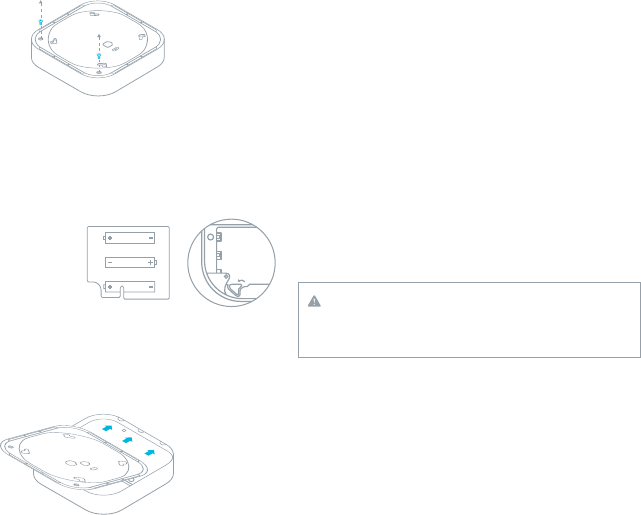
19 18
ALARM LIMITATIONS
LIMITATIONS OF SMOKE ALARMS
Alarms reduce deaths resulting from home fires
worldwide. However smoke alarms can only
work if they are properly located, installed and
maintained, and if smoke reaches the alarms.
• Smoke alarms may not waken all individuals.
Make sure you create an escape plan and you
practice fire drills with all members of the family.
• Smoke alarms cannot work without power. If
they are powered by batteries, the smoke alarms
cannot work if the batteries are missing, dead
or disconnected. If they are wired, the smoke
alarms cannot work during a long power outage
and once the back up battery is dead. Nest
Protect will warn you in advance when batteries
are running low so that you can replace them.
• Smoke will not be able to reach smoke sensor
while the dust cover is in place. The dust cover
must be removed.
• Smoke alarms cannot detect res if the smoke
does not reach the alarms. For example, if a door
is closed, smoke may not reach the smoke
alarm. This is why you should have a smoke
alarm in each bedroom and in the hallways as
bedroom doors may be closed at night.
• Smoke alarms may not be heard. Although
the smoke alarm comes with a loud horn of
85 decibels, it may not be heard if : 1) people
have consumed alcohol or drugs, 2) the alarm
is drowned by noise from stereo, TV, traffic, air
conditioner or other appliances, 3) residents are
hearing impaired or have high frequency hearing
loss associated with aging. Special smoke
alarms should be installed for those who are
hearing impaired.
SAFETY
SERVICING
Step 1: Before sending Nest Protect for service,
visit nest.com/support
Step 2: If your Nest Protect needs servicing, first
contact our support team to get a return number.
Step 3: Send it to
Nest Labs
(YOUR RETURN NUMBER)
4 East Stow Road
Marlton, NJ 08053 USA
RECYCLING AND DISPOSAL
Visit www.nest.com/recycle
ALARM EXPIRATION
Alarms have a limited life. You will need to
replace your Nest Protect no later than 7 years
after the date of manufacture with a brand new
Nest Protect. Check the date of replacement
written on the back of Nest Protect.
WARNING
You’ll no longer be protected from smoke or
CO if you don’t replace your Nest Protect.
About two weeks before it expires, Nest Protect
will light up with a rotating yellow light. Wave at
Nest Protect and it will say, “Nest Protect has
expired. Replace it now.” Buy a new alarm and
recycle the expired one. Make sure you test your
new Nest Protect once it’s installed.
REPLACING THE BACKUP BATTERIES
1. Remove your Nest Protect from its backplate.
2. Using a Phillips-head screwdriver, unscrew the
two screws from the battery door on the back
of Nest Protect.
3. Replace the batteries. Make sure to use
Energizer Ultimate Lithium batteries and
install them in the right order. If you install
them out of order, you may not be able to
close the battery compartment.
4. Reattach the battery door by sliding it into
the tabs located on the opposite side from
the batteries, replacing the screws and then
reattaching Nest Protect back to its base.
5. Press the Nest button to run a test.
1. First battery
2. Second battery
3. Third battery. This
battery will push the
bracket into place.
1
2
3
Page: 19 Page: 18

21 20
(4) On every level of a residential board and care
occupancy (small facility), including basements
and excluding crawl spaces and unfinished attics
(5) *In the living area(s) of a guest suite
(6) In the living area(s) of a residential board and
care occupancy”
(Reprinted with permission from NFPA 72®, National Fire Alarm &
Signaling Code Copyright © 2013 National Fire Protection
Association, Quincy, MA 02269. This reprinted material is not the
complete and official position of the National Fire Protection
Association, on the referenced subject which is represented only by
the standard in its entirety.) (National Fire Alarm & Signaling Code®
and NFPA 72® are registered trademarks of the National Fire
Protection Association, Inc., Quincy, MA 02269.)
SMOKE DETECTION
Are more smoke alarms desirable?
The required number of smoke alarms might
not provide reliable early warning protection
for those areas separated by a door from the
areas protected by the required smoke alarms.
For this reason, the use of additional smoke
alarms for those areas for increased protection is
recommended. The additional areas include the
dining room, and hallways not protected by the
required smoke alarms. The installation of smoke
alarms in kitchens, attics (finished or unfinished),
or garages is not normally recommended,
because these locations occasionally experience
conditions that can result in improper operation.
As Nest Protect is also a Carbon Monoxide alarm,
it is not recommended to install it in a furnace
room or a utility room if it contains a water heater
or a furnace. It should be 15-20 feet from these
appliances to avoid transient conditions and/or
perceived nuisance alarms.
INSTALLATION CODE
THIS EQUIPMENT SHOULD BE INSTALLED IN
ACCORDANCE WITH THE NATIONAL FIRE
PROTECTION ASSOCIATION’S STANDARD 72
(National Fire Protection Association, Battery-
march Park, Quincy, MA 02269).
IMPORTANT! Specific requirements for Smoke
Alarm installation vary from state to state and
from region to region. Check with your local Fire
Department for current requirements in your area.
WARNING
This product is intended for use in ordinary
indoor locations of family living units. It
is not designed to measure compliance
with Occupational Safety and Health
Administration (OSHA) commercial or
industrial standards.
WHERE TO INSTALL YOUR
SMOKE DETECTORS
“For your information, the National Fire Alarm
and Signaling Code, NFPA 72, reads as follows:
“29.5.1 *Required Detection.”
“ *Where required by applicable laws, codes, or
standards for a specific type of occupancy,
approved single- and multiple-station smoke
alarms shall be installed as follows:
(1) *In all sleeping rooms and guest rooms
(2) *Outside of each separate dwelling unit
sleeping area, within 6.4 m (21 ft) of any door to a
sleeping room, the distance measured along a
path of travel
(3) On every level of a dwelling unit, including
basements
• This alarm is not intended to alert hearing
impaired residents. Alarms specifically designed
for the hearing impaired, which feature devices
like ashing strobe lights or low frequency
devices are available to alert the hearing
impaired in case of fire.
• This smoke alarm alone is not a suitable
substitute for complete fire detection systems
in places housing many people—like
apartment buildings, condominiums, hotels,
motels, dormitories, hospitals, long-term
health care facilities, nursing homes, day care
facilities, or group homes of any kind—even if
they were once single-family homes. It is not a
suitable substitute for complete fire detection
systems in warehouses, industrial facilities,
commercial buildings, and special-purpose
non-residential buildings which require special
fire detection and alarm systems. Depending
on the building codes in your area, this smoke
alarm may be used to provide additional
protection in these facilities.
LIMITATIONS OF CO ALARMS
• NEVER ignore your carbon monoxide alarm if it
alarms. Refer to “What to do in case of a carbon
monoxide alarm” for more information. Failure to
do so can result in injury or death.
• This CO alarm is designed for use inside a
single-family home or apartment. It is not meant
to be used in common lobbies, hallways, or
basements of multi-family buildings unless
working CO alarms are also installed in each
family living unit. CO Alarms in common areas
may not be heard from inside individual family
living units.
• This CO alarm alone is not a suitable substitute
for complete detection systems in places
which house many people, like hotels or
dormitories, unless a CO alarm is also placed
in each unit.
• DO NOT use this CO alarm in warehouses,
industrial or commercial buildings, special-
purpose non-residential buildings, or air planes.
This CO alarm is specifically designed for
residential use, and may not provide adequate
protection in non-residential applications.
• Some individuals are more sensitive to CO than
others, including people with cardiac or
respiratory problems, infants, unborn babies,
pregnant mothers, or elderly people can be
more quickly and severely affected by CO.
Members of sensitive populations should
consult their doctors for advice on taking
additional precautions.
• The silence feature is for your convenience only
and will not correct a CO problem. Always check
your home for a potential problem after any
alarm. Failure to do so can result in injury
or death.
Page: 21 Page: 20
23 22
WHERE NOT TO INSTALL YOUR CO ALARMS
• Keep carbon monoxide alarm at least 5 ft (1.5 m)
away from any cooking appliance including
stovetop, oven, microwave, etc.
• This alarm should not be installed in locations
where the normal ambient temperature is below
4.4°C (40°F) or exceeds 37.8°C (100°F).
EXAMPLES OF WHEN YOUR ALARM MAY
NOT BE EFFECTIVE
Your smoke alarm may not be effective in
protecting against fire in certain cases:
• Smoking in bed
• Leaving children unsupervised
• Cleaning with ammable liquids, like gasoline.
• When someone’s clothes have caught on re.
• Fires where the smoke is prevented from
reaching the alarm due to a closed door or
other obstruction.
• Incendiary res where the re grows so rapidly
that an occupant can’t get out, even with
alarms in proper locations.
recommended a smoke alarm to be placed as
far from these fuel-burning sources as possible.
The placement recommendations are intended
to keep a smoke detector at a reasonable
distance from a fuel-burning source, reducing
“unwanted” alarms. Unwanted alarms can
occur if a smoke alarm is placed directly next to
a fuel-burning source. Ventilate these areas as
much as possible.
• In air streams near kitchens. Air currents can
draw cooking smoke into the sensor of
a smoke alarm near the kitchen.
• In very damp, humid or steamy areas, or
directly near bathrooms with showers. Keep a
smoke alarm at least 10 feet (3 meters) away
from showers, saunas, dishwashers, etc.
• Where temperatures are regularly below 40˚F
(4˚C) or above 100˚ F (38˚C) including unheated
buildings, outdoor rooms, porches, or unfinished
attics or basements.
• In very dusty, dirty, or greasy areas. Do not install
a smoke alarm directly over the stove or range.
Clean a laundry room unit frequently to keep it
free of dust or lint.
• Near fresh air vents, ceiling fans, or in very
drafty areas. Drafts can blow smoke away
from a smoke alarm, preventing it from
reaching the sensor.
• In insect infested areas. Insects can
clog openings to the sensor and cause
unwanted alarms.
• Less than 12 inches (30.48 cm) away from
fluorescent lights. Electrical “noise” can
interfere with the sensor.
• In “dead air” spaces. “Dead air” spaces may
prevent smoke from reaching a smoke alarm.
AC INSTALLATION WARNINGS
ELECTRICAL SHOCK HAZARD
• Turn off power to the area where you will
install this unit at the circuit breaker or fuse box
before beginning installation. Failure to turn
off the power before installation may result in
serious electrical shock, injury or death.
• Do not restore power until all alarms are
completely installed. Restoring power before
installation is complete may result in serious
electrical shock, injury or death.
• Turn off the power to the area where the alarm is
installed before removing it from the mounting
bracket. Failure to turn off the power first may
result in serious electrical shock, injury or death.
• If any unit in the series does not alarm, TURN
OFF POWER and recheck connections. If it
does not alarm when you restore power, replace
it immediately.
• Attempting to disconnect the power connector
from the unit when the power is on may result
in electrical shock, serious injury or death.
• Failure to meet any of the above requirements
could damage the units and cause them to
malfunction, removing your protection.
• Improper wiring of the power connector or the
wiring leading to the power connector will
cause damage to the alarm and may lead to a
non-functioning alarm.
• This unit must be powered by a 24-hour, 120V AC
pure sine wave, 60Hz circuit. Be sure the circuit
cannot be turned off by a switch, dimmer, or
ground fault circuit interrupter. Failure to connect
this unit to a 24-hour circuit may prevent it from
providing constant protection.
• The alarm cannot be operated from power
derived from a square wave, modified square
wave or modified sine wave, inverter. These
types of inverters are sometimes used
to supply power to the structure in off grid
installations, such as solar or wind derived
power sources. These power sources produce
high peak voltages that will damage the alarm
• Never disconnect the power from an AC
powered unit to stop an unwanted alarm.
Doing so will disable the unit and remove your
protection. In the case of a true unwanted
alarm open a window or fan the smoke away
from the unit. The alarm will reset automatically
when it returns to normal operation.
• Improper wiring of the power connector or
the wiring leading to the power connector will
cause damage to the alarm and may lead to a
non-functioning alarm. You must test to ensure
proper installation.
WHERE NOT TO INSTALL YOUR
SMOKE ALARMS
For best performance, AVOID installing a smoke
alarm in these areas:
• Where combustion particles are produced.
Burning material creates combustion particles
which could cause your smoke alarm to go off
unnecessarily. Areas to avoid include poorly
ventilated kitchens, garages, boats, recreational
vehicles, and furnace rooms. Keep a smoke
alarm at least 20 feet (6 m) from from the source
of combustion particles (stove, furnace, water
heater, space heater) if possible. In areas where
a 20-foot (6 m) distance is not possible – in
mobile, or smaller homes, for example – it is
Page: 23 Page: 22
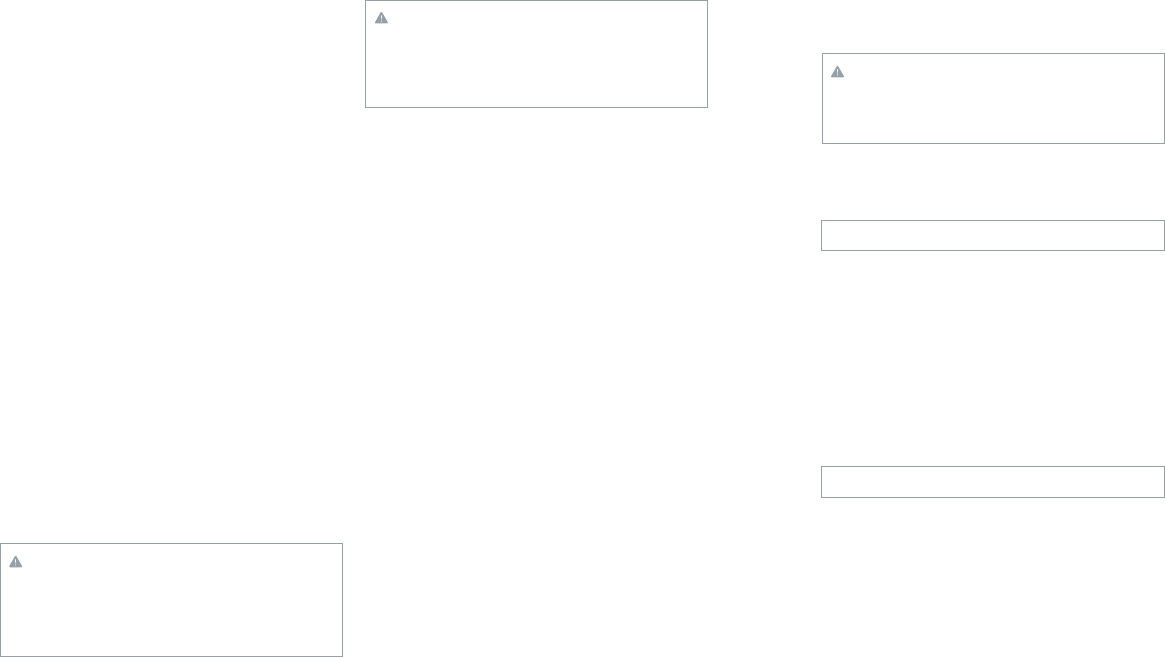
25 24
vehicles are not, and have not been, operating in
an attached garage or adjacent to the residence.
This information is available as a label provided
in the box. Stick it in a spot where everyone can
see it, like the refrigerator.
THE FOLLOWING CONDITIONS CAN RESULT IN
TRANSIENT CO SITUATIONS
1. Excessive spillage or reverse venting of fuel
burning appliances caused by:
I) Outdoor ambient conditions such as wind
direction and/or velocity, including high
gusts of wind; heavy air in the vent pipes
(cold/hu mid air with extended periods
between cycles).
II) Negative pressure differential resulting
from the use of exhaust fans.
III) Simultaneous operation of several fuel
burning appliances competing for limited
internal air.
IV) Vent pipe connection vibrating loose from
clothes dryers, furnaces, or water heaters.
V) Obstructions in or unconventional vent
pipe designs which amplify the above
situations.
2. Extended operation of unvented fuel burning
devices (range, oven, fireplace, etc.)
3. Temperature inversions which can trap
exhaust gases near the ground.
4. Car idling in an open or closed attached
garage, or near a home.
5. NEVER bring a charcoal grill inside and
ALWAYS operate a portable generator outside,
a safe distance from the house, and well away
from windows.
PHONE NUMBER:
PHONE NUMBER:
WHAT TO DO IN CASE OF A CARBON
MONOXIDE ALARM
WARNING
Actuation of your CO alarm indicates the
presence of carbon monoxide (CO) which
can KILL YOU.
If alarm signal sounds:
1) Press the Nest button;
2) Call your emergency services [fire dept. or 911];
3) Immediately move to fresh air – outdoors or by
an open door/window. Do a head count to
check that all persons are accounted for. Do
not reenter the premises nor move away from
the open door/window until the emergency
services responders have arrived, the premises
have been aired out, and your alarm remains in
its normal condition.
4) After following steps 1 – 3, if your alarm
reactivates within a 24 hour period, repeat steps
1 – 3 and call a qualified appliance technician
to investigate for sources of CO from fuel
burning equipment and appliances, and
inspect for proper operation of this equipment.
If problems are identified during this inspection
have the equipment serviced immediately. Note
any combustion equipment not inspected by
the technician and consult the manufacturers’
instructions, or contact the manufacturers
directly, for more information about CO safety
and this equipment. Make sure that motor
WARNING
The alarm only indicates the presence
of carbon monoxide gas at the sensor.
Carbon monoxide gas may be present
in other areas.
Individuals with certain medical problems should
consider using detection devices with lower COHb
alarming capabilities and consider warning
devices which provide audible and visual signals
for carbon monoxide concentrations under 30 ppm.
SYMPTOMS OF CO POISONING
The following symptoms are related to CARBON
MONOXIDE POISONING and are to be discussed
with ALL members of the household:
• Mild Exposure: Slight headache, nausea,
vomiting, fatigue (often described as
‘Flu-like’ symptoms).
• Medium Exposure: Severe throbbing headache,
drowsiness, confusion, fast heart rate.
• Extreme Exposure: Unconsciousness,
convulsions, cardiorespiratory failure, death.
• Many cases of reported CARBON MONOXIDE
POISONING indicate that while victims are
aware they are not well, they become so
disoriented they are unable to save themselves
by either exiting the building or calling for
assistance. Young children and household
pets are typically the first affected.
CARBON MONOXIDE (CO) PRECAUTIONS
WHAT IS CARBON MONOXIDE?
Carbon Monoxide (CO) is an invisible, odorless,
tasteless gas produced when fuels do not burn
completely, or are exposed to heat (usually fire).
These fuels include: wood, coal, charcoal, oil
natural gas, gasoline, kerosene, and propane.
Common appliances are often sources of CO.
such as oil or gas burning furnaces, gas ovens,
wood-burning fireplaces, and charcoal grills. If
they are not properly maintained, are improperly
ventilated or malfunction, CO levels can rise
quickly. CO is a real danger now that homes are
more energy efcient. “Air-tight” homes with
added insulation, sealed windows, and other
weatherproong can “trap” CO inside.
Electrical appliances typically do not produce CO.
The Nest Protect CO sensor meets the alarm
response time requirements of the American Na-
tional Standard ANSI/UL 2034. Standard alarm
times are as follows:
• At 70 PPM, the unit must alarm within
60-240 minutes.
• At 150 PPM, the unit must alarm within
10-50 minutes.
• At 400PPM, the unit must alarm within
4-15 minutes.
WARNING
This carbon monoxide alarm is designed
to detect carbon monoxide from any source
of combustion. It is NOT designed to detect
any other gas.
Page: 25 Page: 24
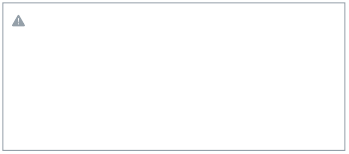
27 26
FEDERAL COMMUNICATIONS
COMMISSION (FCC) COMPLIANCE
This equipment has been tested and found to
comply with the limits for a Class B digital device,
pursuant to part 15 of the FCC Rules. These limits
are designed to provide reasonable protection
against harmful interference in a residential
installation. This equipment generates, uses and
can radiate radio frequency energy and, if not
installed and used in accordance with the
instructions, may cause harmful interference
to radio communications. However, there is no
guarantee that interference will not occur in a
particular installation. If this equipment does
cause harmful interference to radio or television
reception, which can be determined by turning the
equipment off and on, the user is encouraged to
try to correct the interference by one or more of
the following measures:
• Reorient or relocate the receiving antenna.
• Increase the separation between the equipment
and receiver.
• Connect the equipment into an outlet on a
circuit different from that to which the receiver
is connected.
• Consult the dealer or an experienced radio/TV
technician for help.
This device complies with part 15 of FCC rules.
Operation is subject to the following two conditions:
1. This device may not cause harmful interference.
2. This device must accept any interference
received, including interference that may cause
undesired operation.
Change or modifications that are not expressly
approved by the manufacturer could void the
user’s authority to operate the equipment.
RF EXPOSURE INFORMATION:
This equipment complies with FCC radiation
exposure limits set forth for an uncontrolled
environment. In order to avoid the possibility of
exceeding the FCC radio frequency exposure
limits, human proximity to the antenna shall not
be less than 20cm during normal operation.
MOBILE NOTIFICATIONS
WARNING
Nest Protect smartphone and tablet
notifications require a functional Wi-Fi
connection. They’re only as reliable as
your home’s Wi-Fi network and aren’t a
substitute for a third party emergency
monitoring service.
This installation guide and the products described herein are
copyrighted, with all rights reserved. Under these copyright laws,
no part of this installation guide may be copied for use without the
written consent of Nest.
Nest Labs. 900 Hansen Way. Palo Alto, CA 94304
WHAT TO DO IN CASE OF FIRE
• Get out now.
• Don’t panic; stay calm.
• Operate your safety plan as previously planned.
• Alert small children in the home and those who
may need extra assistance.
• Leave the building as quickly as possible. Touch
doors with the back of your hand and make sure
they are not hot before opening them. Use an
alternate exit, if necessary. In case of smoke,
crawl along the oor, and DO NOT stop to
collect anything. Close the doors behind you.
• Meet at a pre-arranged meeting place outside
the building.
• Once outside, do a head count, and call the
fire department.
• DO NOT reenter the house, unless a re ofcial
says it’s safe to reenter.
CALIFORNIA STATE FIRE MARSHAL
As stated by the California State Fire Marshal
“Early warning re detection is best achieved by
the installation of fire detection equipment in all
rooms and areas of the household as follows: A
smoke alarm installed in each separate sleeping
area (in the vicinity of, but outside of the bed-
rooms), and heat or smoke detectors in the
living rooms, dining rooms, bedrooms, kitchens,
hallways, attics, furnace rooms, closets, utility and
storage rooms, basements and attached garages”.
FIRE SAFETY PRECAUTIONS
CREATE AN ESCAPE PLAN TO PRACTICE
Be prepared when your smoke/CO alarm sounds its
alarm. Develop a family escape plan, discuss it with
all household members, and practice it regularly.
• Make sure everyone is familiar with the sound
of your smoke/CO alarm and explain what the
sound means.
• Determine TWO exits from each room and have
an escape route to the outside from each exit.
• Teach all the members in your household to
check doors for heat with the back of your hand
before opening them, and to use the alternate
exit if the door is hot. Make sure they do not
open the door if it is hot.
• Teach household members to crawl along the
oor to avoid dangerous smoke, fumes and gases.
• Determine a safe meeting place for all household
members to regroup at outside the building.
PRACTICE FIRE SAFETY
Practice your escape plan at least twice a year,
making sure that everyone is involved – from kids
to grandparents. Practice the escape plan with
children, including holding one at night when they
are sleeping. If children or others do not wake up
to the sound of the smoke alarm, or if there are in-
fants or family members with mobility limitations,
make sure that someone is assigned to help them
for the fire drill and in the event of an emergency.
Current studies have shown smoke alarms may
not awaken all sleeping individuals, and that it is
the responsibility of individuals in the household
that are capable of assisting others to provide
assistance to those who may not be awakened by
the alarm sound, or to those who may be incapable
of safely evacuating the area unassisted.
Page: 27 Page: 26
29 28
Page: 29 Page: 28
31 30
Page: 31 Page: 30
33 32
Page: 33 Page: 32
35 34
Page: 35 Page: 34
37 36
Page: 37 Page: 36
39 38
Page: 39 Page: 38
41 40
Page: 41 Page: 40
43 42
Page: 43 Page: 42
45 44
Page: 45 Page: 44

46
Nest Protect Wired 120V
Detects smoke, carbon monoxide and heat.
Installation Guide
64-10-0018-ES
Page: 46